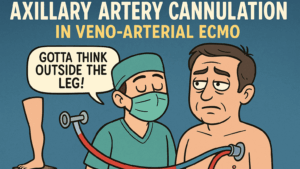Acute renal failure (ARF) remains a significant postoperative complication in patients undergoing cardiac surgery, contributing to increased morbidity, prolonged intensive care unit (ICU) stays, and higher healthcare costs. This prospective clinical study, published in Medical Science Monitor, investigates the utility of intraoperative renal near-infrared spectroscopy (NIRS) as a non-invasive, continuous tool for monitoring renal oxygenation and predicting postoperative ARF in patients undergoing open-heart surgery with cardiopulmonary bypass (CPB).
A total of 357 patients were included, following strict inclusion criteria such as normal preoperative renal function and a skin-to-kidney distance ≤4 cm to ensure the accuracy of NIRS measurements. Patients were monitored intraoperatively using bilateral NIRS sensors at the T12/L2 vertebral level. Renal tissue oxygen saturation (rSO₂) was measured at various phases of surgery: pre-induction, post-induction, pre-CPB, during hypothermia, rewarming, and post-CPB.
ARF was diagnosed based on Kidney Disease Improving Global Outcomes (KDIGO) criteria, and 44 patients (12.3%) developed ARF postoperatively. These patients were older and had significantly longer surgery, CPB, and aortic cross-clamp times, indicating increased surgical complexity and physiological stress. Furthermore, they required more intraoperative blood products and inotropic support, with higher utilization of intra-aortic balloon pumps (IABPs).
A critical finding of the study was the correlation between the duration of renal oxygen desaturation and ARF risk. Time spent below rSO₂ thresholds of 80%, 70%, and 60% from baseline was significantly longer in the ARF group. For instance, ARF patients spent an average of 204 minutes with rSO₂ below 80%, compared to 143 minutes in non-ARF patients. Even more stark was the time below 60%: ARF patients averaged 58 minutes, while the non-ARF group spent less than 2 minutes below this threshold.
Receiver Operating Characteristic (ROC) analysis further underscored the predictive power of NIRS monitoring. Time spent below 60% rSO₂ for more than 30 minutes predicted ARF with 86.4% sensitivity and 96.5% specificity. These robust findings indicate that NIRS can act as an early warning system, enabling clinicians to initiate timely interventions such as fluid resuscitation and hemodynamic support to mitigate renal damage.
Postoperative outcomes revealed that patients who developed ARF had significantly longer ICU stays, higher rates of respiratory distress requiring CPAP, and more frequent wound infections. This confirms the increased clinical burden associated with ARF and the need for vigilant monitoring and intervention.
The study’s strengths include its large sample size, prospective design, and rigorous methodology, including the standardization of NIRS placement and measurement protocols. The exclusion of patients with poor NIRS signal penetration (skin-to-kidney distance >4 cm) ensured data accuracy and enhanced the study’s validity. Compared to earlier studies with limited cohorts or inconsistent methodologies, this research offers compelling evidence supporting the integration of renal NIRS monitoring into standard cardiac surgical practice.
Limitations of the study include its single-center setting and use of multiple surgical teams, potentially introducing variability in operative technique and postoperative care. Additionally, long-term renal outcomes beyond hospital discharge were not assessed, leaving a gap in understanding the chronic impact of intraoperative desaturation events.
In conclusion, intraoperative NIRS monitoring provides a valuable, real-time insight into renal oxygenation during cardiac surgery. Its ability to predict ARF using well-defined thresholds and durations supports its adoption as a standard intraoperative monitoring tool, particularly in high-risk patients. This study not only enhances the perioperative management strategy but also paves the way for reducing renal complications and improving overall surgical outcomes.







